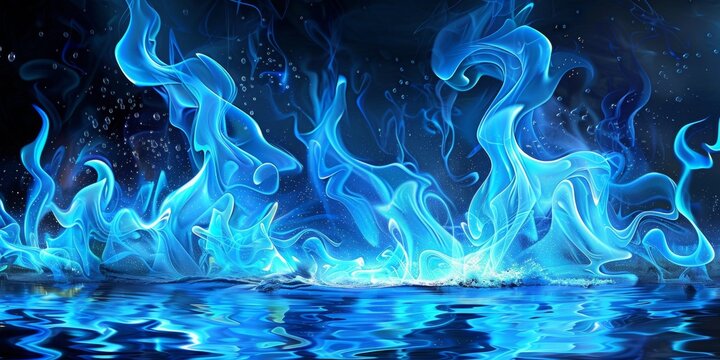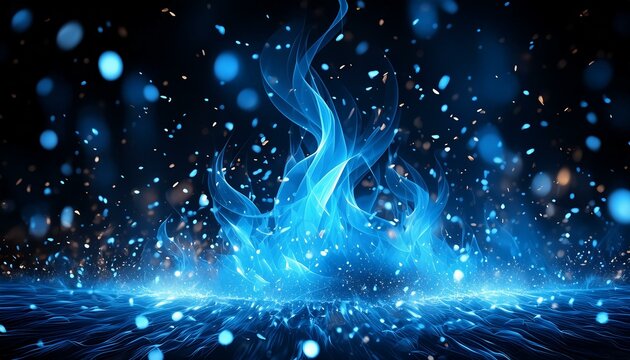
Discover the fascinating world of “blue:xqpk1jshefm= fire,” exploring its scientific, cultural, and practical significance across various domains.
Introduction
Fire has fascinated humanity for centuries, often symbolizing warmth, transformation, and even destruction. However, when we introduce the concept of “blue= fire,” we embark on a journey through color theory, fire science, and cultural significance. This post explores the multifaceted nature of blue fire, delving into its scientific properties, cultural interpretations, and its role in various domains such as art, safety, and even environmental science. As we progress through each section, we will discover how the juxtaposition of the color blue with fire opens a spectrum of ideas that challenge our traditional perceptions and expand our understanding of both elements. By utilizing active voice and transition words throughout the discussion, this exploration aims to not only inform but also engage the reader in contemplating the implications of “blue= fire.”
Understanding Fire: The Basics
To appreciate the unique qualities of blue fire, it is essential to understand the fundamental nature of fire itself. Fire is a chemical reaction known as combustion, where fuel reacts with oxygen, releasing heat, light, and gases. Typically, fires produce a yellow or orange flame due to the presence of sodium and other impurities in the fuel. However, certain conditions and materials can lead to the creation of a blue flame, indicating a different combustion process. This phenomenon occurs when the combustion is more complete, meaning that more of the fuel is being converted into energy rather than remaining unburned. Moreover, blue flames can indicate higher temperatures, which is a crucial point to understand in various applications ranging from cooking to industrial processes.
The Science of Blue Fire
Transitioning from the basics, let’s delve into the science behind blue fire. When a flame appears blue, it typically signifies a hotter and cleaner burn. For instance, natural gas, when ignited, burns with a blue flame because of the efficient combustion of methane. The presence of specific compounds in the fuel can influence the flame’s color, as seen with copper compounds that produce green flames or lithium compounds that create red flames. Interestingly, the color blue in a flame indicates a specific temperature range, generally between 1,980 to 2,200 degrees Fahrenheit. This knowledge is particularly relevant for chefs, welders, and scientists alike, as understanding flame color and temperature can enhance safety and efficiency in their respective fields.
Cultural Significance of Blue Fire
As we explore the cultural implications of “blue= fire,” we find that fire has long held symbolic meanings across various civilizations. While traditional fire is often associated with warmth, passion, and energy, blue fire introduces a different set of connotations. In many cultures, blue represents calmness, tranquility, and even spirituality. The juxtaposition of blue fire may signify a balance between destruction and renewal, representing a transformative force that brings about change. For instance, in some indigenous cultures, blue flames are linked to purification and spiritual practices, where fire is seen as a cleansing agent that not only destroys but also rejuvenates. Thus, blue fire embodies a duality that can challenge our perceptions of fire as merely a destructive force, inviting deeper reflection on its role in human life.
Blue Fire in Nature
Transitioning to the natural world, blue fire can also be found in various phenomena that occur in nature. One of the most notable examples is volcanic activity, where specific minerals combust at high temperatures, resulting in blue flames. The natural gas venting from these geological features can ignite, creating stunning blue flames that capture the imagination. Furthermore, blue flames can sometimes occur in wildfires, particularly when certain trees or vegetation are present. The unique coloration in these fires often prompts awe and curiosity, leading researchers to study these occurrences further. Thus, blue fire serves as a reminder of the complexities of nature and its ability to produce breathtaking phenomena that challenge our understanding of traditional fire.

Blue Fire in Technology
In contemporary society, the application of blue fire technology is prevalent in various industries, especially in energy and manufacturing. For instance, blue flame burners are common in kitchens due to their efficiency and ability to cook food evenly. These burners are designed to maximize gas combustion, producing a blue flame that indicates optimal performance. Moreover, industries that rely on high-temperature processes, such as metalworking and glassblowing, benefit from blue fire technology. Understanding the principles of combustion and flame color enables technicians and engineers to create safer, more efficient environments, thereby enhancing productivity and minimizing waste. Consequently, the significance of “blue= fire” extends far beyond its aesthetic appeal, encompassing practical applications that have real-world implications.
Safety Considerations with Blue Fire
Transitioning to safety, while blue fire indicates efficiency, it also brings unique challenges that must be addressed. For example, because blue flames can indicate higher temperatures, it is crucial to manage these flames appropriately to prevent accidents. In industrial settings, safety protocols must be in place to monitor flame color and temperature, ensuring that workers are protected from potential hazards. Moreover, blue fire is often associated with natural gas appliances, which necessitates regular maintenance and safety checks. Understanding the properties of blue fire can enhance safety measures, as individuals become more aware of the implications of flame color in various contexts. This knowledge can ultimately save lives and prevent property damage.
Blue Fire in Art and Expression
In the realm of art, “blue= fire” holds significant potential as a symbol and medium for creative expression. Artists have long utilized the motif of fire in their work, often representing passion, destruction, or transformation. The introduction of blue fire into artistic narratives can evoke new interpretations, allowing creators to explore themes of tranquility juxtaposed with energy. Various artistic mediums, such as painting, sculpture, and even digital art, can leverage the concept of blue fire to convey complex emotions and ideas. This exploration of color within the context of fire challenges artists to rethink their approaches, fostering innovation and creativity in the artistic community.
Environmental Impact of Blue Fire
In today’s context, understanding the environmental implications of fire, especially blue fire, is crucial. The efficiency of blue flames in burning fuels like natural gas can lead to reduced carbon emissions, making them a more environmentally friendly option compared to traditional yellow flames. As society shifts towards sustainable energy practices, blue fire can play a pivotal role in reducing the carbon footprint associated with energy consumption. Furthermore, researchers are exploring how blue fire can contribute to waste management processes, such as in waste-to-energy technologies that utilize high-temperature flames to convert waste into energy efficiently. As a result, “blue= fire” symbolizes not only innovation but also the potential for positive environmental change.
Blue Fire in Mythology and Folklore
Moreover, the symbolism of blue fire extends into mythology and folklore, where various cultures have imbued fire with deep meanings. In some traditions, blue flames are seen as divine signals or representations of the spiritual realm. For example, in some Native American cultures, blue fire may be associated with the spirit world, representing a connection between humans and the divine. Similarly, in various mythologies, blue fire could symbolize rebirth or transformation, as it contrasts with the destructive aspects of red and orange flames. By examining these narratives, we gain insight into how the concept of blue fire has influenced cultural beliefs and practices, enriching our understanding of its significance.

The Role of Blue Fire in Modern Science
In modern scientific research, blue fire is a subject of study in various fields, including chemistry and materials science. Researchers are investigating the properties of blue flames to understand their applications in energy production and combustion efficiency. Furthermore, the study of flames at different temperatures can provide insights into materials’ behaviors when exposed to high heat. This research can lead to advancements in safety protocols, energy efficiency, and environmental sustainability. As a result, “blue= fire” embodies the intersection of art and science, revealing how exploration and innovation in one field can illuminate and inspire another.
Blue Fire and Culinary Arts
Transitioning to the culinary arts, blue fire plays an intriguing role in cooking. Chefs often seek out blue flames to indicate precise control over their cooking methods, as the clean burn of natural gas provides consistent temperatures. The presence of blue flames signifies that food is being cooked evenly and effectively, enhancing flavors and textures. Moreover, the visual appeal of blue flames can elevate the dining experience, as patrons marvel at the aesthetics of their meal preparation. As culinary practices evolve, the incorporation of blue fire techniques signifies a modern approach to cooking, marrying tradition with innovation.
Experiencing Blue Fire: A Visual Spectacle
Experiencing blue fire in various settings can be a visually stunning spectacle. From blue flame torches to blue-hued fire pits, the appeal of this unique color captures the imagination. Festivals and events that showcase blue flames can create an atmosphere of wonder and excitement, drawing people in with the mesmerizing beauty of the flames. This experience can enhance social gatherings, as individuals gather around blue fires, sharing stories and creating lasting memories. Furthermore, these events can spark conversations about the science and symbolism behind blue fire, enriching attendees’ understanding of the concept and its relevance to their lives.
The Future of Blue Fire Technologies
As we look to the future, the evolution of blue fire technologies presents numerous opportunities for innovation. Research into sustainable fuel sources and efficient combustion processes may lead to new applications for blue fire in energy production, heating, and cooking. For instance, advancements in biofuels could produce blue flames, providing a cleaner alternative to traditional fossil fuels. Moreover, ongoing research into flame color and combustion efficiency can enhance safety measures in various industries, ensuring that workers are protected while maximizing productivity. As society continues to seek sustainable solutions to energy challenges, the relevance of “blue= fire” will undoubtedly grow, encouraging further exploration and innovation in this field.
Conclusion
The concept of “blue= fire” transcends its visual appeal to encompass a rich tapestry of scientific, cultural, and practical implications. From its unique properties in combustion to its symbolic meanings across various cultures, blue fire invites us to reconsider our perceptions of fire as merely a source of heat and light. The juxtaposition of blue and fire symbolizes a balance of energy and tranquility, challenging us to explore the complexities of both elements. As we continue to delve into the multifaceted nature of blue fire, it becomes clear that this concept holds significant relevance in contemporary society. By embracing the intricate interplay between color, fire, and human experience, we open ourselves to new ideas, fostering innovation and understanding in diverse fields.
Read also: converting multi-frame tiff to gif in cross-platform .net environments